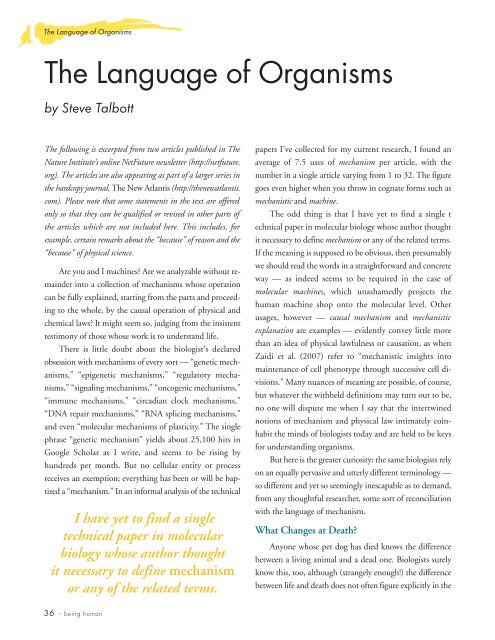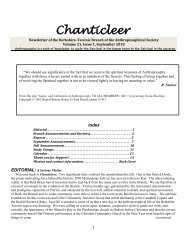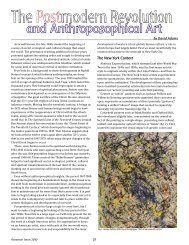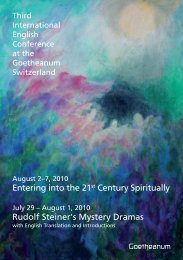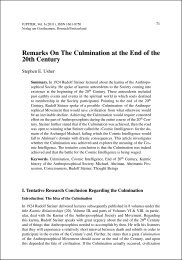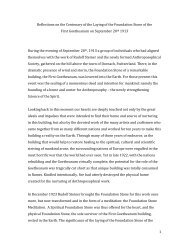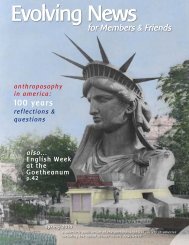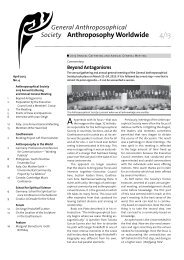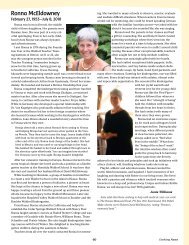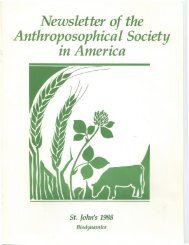Rudolf Steiner's Vision for the Future - Anthroposophical Society in ...
Rudolf Steiner's Vision for the Future - Anthroposophical Society in ...
Rudolf Steiner's Vision for the Future - Anthroposophical Society in ...
You also want an ePaper? Increase the reach of your titles
YUMPU automatically turns print PDFs into web optimized ePapers that Google loves.
XXXXXXX The Language of Organisms<br />
The Language of Organisms<br />
by Steve Talbott<br />
The follow<strong>in</strong>g is excerpted from two articles published <strong>in</strong> The<br />
Nature Institute’s onl<strong>in</strong>e Net<strong>Future</strong> newsletter (http://netfuture.<br />
org). The articles are also appear<strong>in</strong>g as part of a larger series <strong>in</strong><br />
<strong>the</strong> hardcopy journal, The New Atlantis (http://<strong>the</strong>newatlantis.<br />
com). Please note that some statements <strong>in</strong> <strong>the</strong> text are offered<br />
only so that <strong>the</strong>y can be qualified or revised <strong>in</strong> o<strong>the</strong>r parts of<br />
<strong>the</strong> articles which are not <strong>in</strong>cluded here. This <strong>in</strong>cludes, <strong>for</strong><br />
example, certa<strong>in</strong> remarks about <strong>the</strong> “because” of reason and <strong>the</strong><br />
“because” of physical science.<br />
Are you and I mach<strong>in</strong>es? Are we analyzable without rema<strong>in</strong>der<br />
<strong>in</strong>to a collection of mechanisms whose operation<br />
can be fully expla<strong>in</strong>ed, start<strong>in</strong>g from <strong>the</strong> parts and proceed<strong>in</strong>g<br />
to <strong>the</strong> whole, by <strong>the</strong> causal operation of physical and<br />
chemical laws? It might seem so, judg<strong>in</strong>g from <strong>the</strong> <strong>in</strong>sistent<br />
testimony of those whose work is to understand life.<br />
There is little doubt about <strong>the</strong> biologist’s declared<br />
obsession with mechanisms of every sort — “genetic mechanisms,”<br />
“epigenetic mechanisms,” “regulatory mechanisms,”<br />
“signal<strong>in</strong>g mechanisms,” “oncogenic mechanisms,”<br />
“immune mechanisms,” “circadian clock mechanisms,”<br />
“DNA repair mechanisms,” “RNA splic<strong>in</strong>g mechanisms,”<br />
and even “molecular mechanisms of plasticity.” The s<strong>in</strong>gle<br />
phrase “genetic mechanism” yields about 25,100 hits <strong>in</strong><br />
Google Scholar as I write, and seems to be ris<strong>in</strong>g by<br />
hundreds per month. But no cellular entity or process<br />
receives an exemption; everyth<strong>in</strong>g has been or will be baptized<br />
a “mechanism.” In an <strong>in</strong><strong>for</strong>mal analysis of <strong>the</strong> technical<br />
I have yet to f<strong>in</strong>d a s<strong>in</strong>gle<br />
technical paper <strong>in</strong> molecular<br />
biology whose author thought<br />
it necessary to def<strong>in</strong>e mechanism<br />
or any of <strong>the</strong> related terms.<br />
36 • be<strong>in</strong>g human<br />
papers I’ve collected <strong>for</strong> my current research, I found an<br />
average of 7.5 uses of mechanism per article, with <strong>the</strong><br />
number <strong>in</strong> a s<strong>in</strong>gle article vary<strong>in</strong>g from 1 to 32. The figure<br />
goes even higher when you throw <strong>in</strong> cognate <strong>for</strong>ms such as<br />
mechanistic and mach<strong>in</strong>e.<br />
The odd th<strong>in</strong>g is that I have yet to f<strong>in</strong>d a s<strong>in</strong>gle t<br />
echnical paper <strong>in</strong> molecular biology whose author thought<br />
it necessary to def<strong>in</strong>e mechanism or any of <strong>the</strong> related terms.<br />
If <strong>the</strong> mean<strong>in</strong>g is supposed to be obvious, <strong>the</strong>n presumably<br />
we should read <strong>the</strong> words <strong>in</strong> a straight<strong>for</strong>ward and concrete<br />
way — as <strong>in</strong>deed seems to be required <strong>in</strong> <strong>the</strong> case of<br />
molecular mach<strong>in</strong>es, which unashamedly projects <strong>the</strong><br />
human mach<strong>in</strong>e shop onto <strong>the</strong> molecular level. O<strong>the</strong>r<br />
usages, however — causal mechanism and mechanistic<br />
explanation are examples — evidently convey little more<br />
than an idea of physical lawfulness or causation, as when<br />
Zaidi et al. (2007) refer to “mechanistic <strong>in</strong>sights <strong>in</strong>to<br />
ma<strong>in</strong>tenance of cell phenotype through successive cell divisions.”<br />
Many nuances of mean<strong>in</strong>g are possible, of course,<br />
but whatever <strong>the</strong> withheld def<strong>in</strong>itions may turn out to be,<br />
no one will dispute me when I say that <strong>the</strong> <strong>in</strong>tertw<strong>in</strong>ed<br />
notions of mechanism and physical law <strong>in</strong>timately co<strong>in</strong>habit<br />
<strong>the</strong> m<strong>in</strong>ds of biologists today and are held to be keys<br />
<strong>for</strong> understand<strong>in</strong>g organisms.<br />
But here is <strong>the</strong> greater curiosity: <strong>the</strong> same biologists rely<br />
on an equally pervasive and utterly different term<strong>in</strong>ology —<br />
so different and yet so seem<strong>in</strong>gly <strong>in</strong>escapable as to demand,<br />
from any thoughtful researcher, some sort of reconciliation<br />
with <strong>the</strong> language of mechanism.<br />
What Changes at Death?<br />
Anyone whose pet dog has died knows <strong>the</strong> difference<br />
between a liv<strong>in</strong>g animal and a dead one. Biologists surely<br />
know this, too, although (strangely enough!) <strong>the</strong> difference<br />
between life and death does not often figure explicitly <strong>in</strong> <strong>the</strong>


